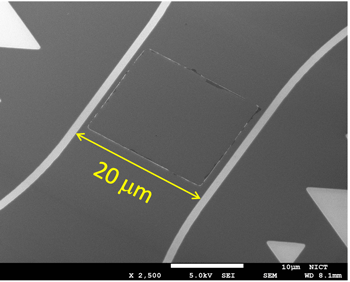The National Institute of Information and Communications Technology (NICT), under the leadership of President Hideyuki Tokuda, Ph.D., has introduced an innovative design for a superconducting strip photon detector, facilitating remarkably efficient photon detection across a wide strip.
 Developed Superconducting Wide-Strip Photon Detector (SWSPD). Image Credit: National Institute of Information and Communications Technology.
Developed Superconducting Wide-Strip Photon Detector (SWSPD). Image Credit: National Institute of Information and Communications Technology.
This breakthrough has resulted in the creation of the world’s inaugural “Superconducting Wide-Strip Photon Detector (SWSPD).”
The strip width of the detector surpasses that of conventional Superconducting NanoStrip Photon Detectors (SNSPDs) by more than 200 times. This groundbreaking technology addresses the longstanding issues of low productivity and polarization dependence inherent in traditional SNSPDs.
The innovative SWSPD is poised for application in a range of cutting-edge technologies, including quantum information communication and quantum computing, paving the way for the early integration of these advanced technologies into society.
These findings were formally presented in the US scientific journal Optica Quantum on October 26, 2023.
Background
Photon detection technology stands as a pivotal cornerstone for driving innovation across a diverse spectrum of advanced technology domains. These domains encompass not only the well-established areas of quantum information communication and quantum computing, which are currently experiencing extensive global research and development, but also extend to fields like live cell fluorescent observation, deep space optical communication, laser sensing, and more.
Within this context, the National Institute of Information and Communications Technology (NICT) has undertaken the development of a Superconducting NanoStrip Photon Detector (SNSPD) with an ultra-narrow strip width of 100 nm or less.
The endeavors have borne fruit, as the researchers not only achieved superior performance compared to other photon detectors but have also effectively showcased its utility through its application in quantum information communication technology.
However, the production of SNSPDs necessitates the creation of nanostructured strips employing sophisticated nanofabrication techniques. This process introduces performance discrepancies among detectors and acts as a barrier to enhancing productivity.
Furthermore, the inherent polarization dependence resulting from the meandering structure of superconducting nanostrips has restricted the scope of its use as a photon detector.
Achievements
In this study, NICT has pioneered a groundbreaking design termed the "High Critical Current Bank (HCCB) structure,” revolutionizing photon detection capabilities in superconducting strip photon detectors.
Through this innovation, NICT successfully crafted a Superconducting Wide-Strip Photon Detector (SWSPD) with a substantial 20 µm width. This width exceeds that of conventional nanostrip photon detectors by over 200 times, marking a historic milestone in achieving high-performance operation.
The previously developed nanostrip variant required the intricate fabrication of extremely lengthy superconducting nanostrips, each with a width of 100 nm or less, following a meandering pattern.
In contrast, the wide-strip type can be fashioned with a single, shorter, straight superconducting strip. Importantly, the SWSPD obviates the need for specialized nanofabrication techniques and can be produced using highly efficient, general-purpose photolithography technology.
Furthermore, the expanded strip width exceeds that of the incident light spot emanating from the optical fiber, effectively eliminating the polarization dependence encountered in the nanostrip-type detectors.
Upon assessing the detector's performance, it exhibited a remarkable detection efficiency of 78% in the telecommunication wavelength band (λ = 1,550 nm), closely matching the 81% efficiency of the nanostrip-type detectors. Additionally, the timing jitter exhibited superior numerical values compared to its nanostrip counterpart.
Future Prospects
This accomplishment paves the way for the creation of photon detectors boasting heightened efficiency and superior performance attributes compared to the prevalent nanostrip technology, which has long held a crucial role in advanced technology sectors like quantum information communication.
This technology holds the potential for widespread application in various quantum information communication technologies and plays a foundational role in the realization of networked quantum computers as outlined in JST Moonshot Goal 6.
In the forthcoming stages, researchers will continue their exploration of the HCCB structure within SWSPD, with the aim of achieving high-efficiency photon detection not only within the telecommunication wavelength range but also spanning a broad spectrum from visible to mid-infrared wavelengths.
Furthermore, they aspire to expand the size of the photon-receiving area, thereby broadening its applications, including deep space optical communication technology, laser sensing, live cell observation, and more.
Journal Reference:
Yabuno, M., et al. (2023). Superconducting wide strip photon detector with high critical current bank structure. Optica Quantum. doi.org/10.1364/opticaq.497675.